database operation
Allow remote login
grant all privileges on . to root@‘%’ identified by ‘密码’ WITH GRANT OPTION
DDL – database operations
DDL-Query
query all databases
SHOW DATABASES;
Query the current database
SELECT DATABASE();
create database
CREATE DATABASE [IF NOT EXISTS] 数据库名 [DEFAULT CHARSET 字符集] [COLLATE 排序规则];
delete database
DROP DATABASE [IF EXISTS] 数据库名;
use database
USE 数据库名;
Query all tables in the current database
SHOW TABLES;
query table structure
DESC 表名;
Query the specified table creation statement
SHOW CREATE TABLE 表名
DDL-table operation-create
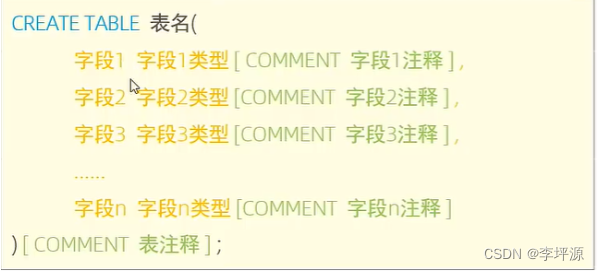
DDL-table operation-modify
add field
ALTER TABLE 表名 ADD 字段名 类型(长度) [COMMENT 注释] [约束];
modify data type
ALTER TABLE 表名 MODITY 字段名 新数据类型(长度);
Modify field name and field type
ALTER TABLE 表名 CHANGE 旧字段名 新字段名 类型(长度) [COMMENT '注释'] [约束];
Modify field position
Modify field 1 to follow field 2
ALTER TABLE 表名 CHANGE 字段名1 字段名1 VARCHAR(50) AFTER 字段名2
delete field
ALTER TABLE 表名 DROP 字段名;
modify table name
ALTER TABLE 表名 RENAME TO 新表名;
delete table
DROP TABLE [IF EXISTS] 表名;
DML - Data Manipulation Language
DML - add data
1. Add data to the specified field
INSERT INTO 表名 (字段名1,字段名2,...) VALUES(值1,值2,...);
2. Add data to all fields
INSERT INTO 表名 VALUES(值1,值2,...);
3. Add data in batches
INSERT INTO 表名 (字段名1,字段名2,...) VALUES(值1,值2,...),值1,值2,...),值1,值2,...);
INSERT INTO 表名 VALUES(值1,值2,...),值1,值2,...),值1,值2,...);
DML - modify data
UPDATE 表名 SET 字段名1=值1,字段名2=值2 [WHERE 条件];
If the where condition is not written, the entire table is modified
DML - delete data
DELETE FROM 表名 [WHERE 条件]
Notice:
- The condition of the DELETE statement may or may not be present. If there is no condition, all data in the entire table will be deleted.
- The DELETE statement cannot delete the value of a certain field (UPDATE can be used).
DQL - Data Query Language
The full English name of DQL is Data Query Language (Data Query Language), a data query language used to query records in tables in the database.
DQL-syntax
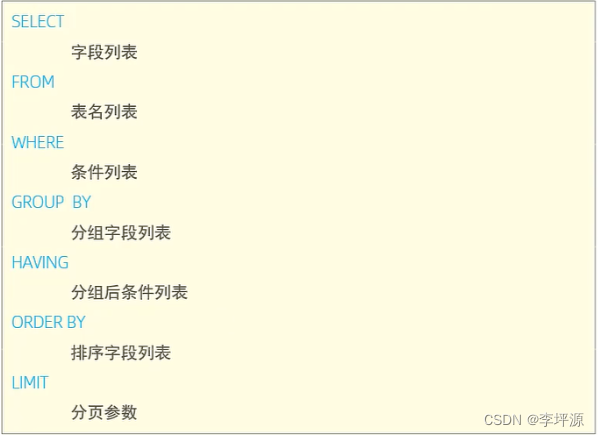
DQL - basic query
1. Query multiple fields
select 字段1,字段2,字段3... from 表名;
select * from 表名;
2. Set an alias
select 字段1 [as 别名1],字段2 [as 别名2]... from 表名;
3. Remove duplicate records
select distinct 字段列表 from 表名;
DQL-Conditional query
1. Grammar
select 字段列表 from 表名 where 条件列表;
2. Conditions
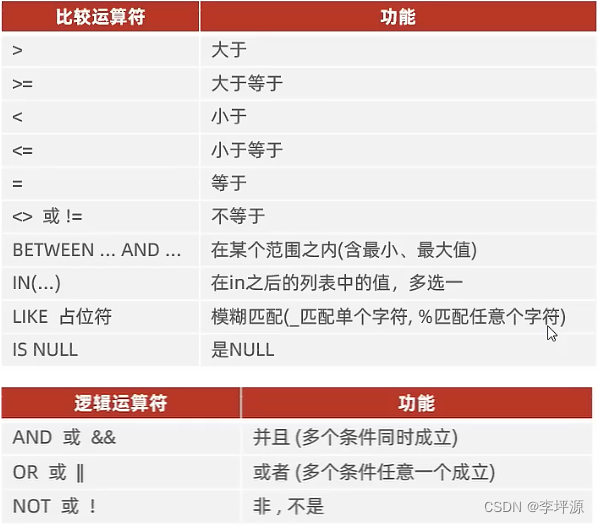
DQL - aggregate functions
1 Introduction
Take a column of data as a whole and perform longitudinal calculations
2. Common aggregation functions
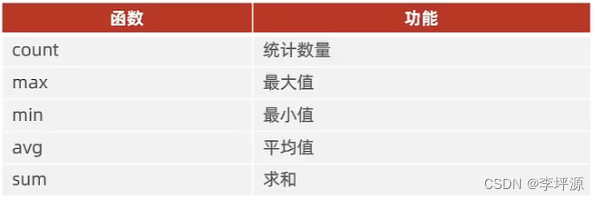
3. Grammar
select 聚合函数(字段列表) from 表名;
DQL-group query
1. Grammar
select 字段列表 from 表名 [where 条件] group by 分组字段名 [having 分组后过滤条件];
The difference between where and having
- The execution timing is different: where is to filter before grouping, if the where condition is not met, do not participate in grouping; and having is to filter the results after grouping.
- The judgment conditions are different: where cannot judge the aggregation function, but having can.
Notice
Execution order: where > aggregate function > having.
After grouping, the fields to be queried are generally aggregation functions and grouping fields, and it is meaningless to query other fields.

DQL - sort query
1. Grammar
select 字段列表 from 表名 order by 字段1 排序方式1,字段2 排序方式2;
2. Sort by
- ASC : ascending order (default)
- DESC: descending order
Note: If it is multi-field sorting, when the first field has the same value, it will be sorted according to the second field.
DQL-Paging query
1. Grammar
select 字段列表 from 表名 LIMIT 起始索引,查询记录数;
Notice
- The starting index starts from 0, starting index = (query page number - 1) * number of records displayed on each page.
- Pagination query is a database dialect, and different databases have different implementations. In MySQL, it is LIMIT.
- If the first page of data is being queried, the starting index can be omitted, which can be abbreviated as limit 10.
DQL - order of execution
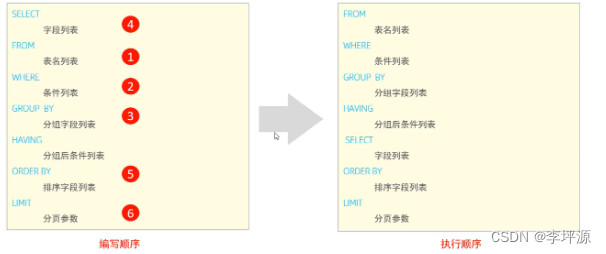
DCL - Data Control Language
DCL-Introduction
The full English name of DCL is Data Control Language (Data Control Language), which is used to manage database users and control database access rights.
DCL-admin user
1. Query users
USE mysql;
SELECT * FROM user;
2. Create a user
ALTER USER '用户名'@'主机名' IDENTIFIED BY '密码';
3. Modify user password
ALTER USER '用户名'@'主机名' IDENTIFIED WITH mysql_native_password BY '新密码';
4. Delete user
DROP USER '用户名'@'主机名';
Notice:
- Hostnames can use % wildcards.
- This type of SQL developers operate less, mainly used by DBA (Database Administrator database administrator).
DCL-Access Control
1. Query permission
show grants for '用户名'@'主机名';
2. Grant permissions
gant 权限列表 on 数据库名.表名 to '用户名'@'主机名';
3. Revoke permissions
REVOKE 权限列表 ON 数据库名.表名 FROM '用户名'@'主机名';
Notice:
- Between multiple permissions, use commas to separate
P USER 'username'@'hostname';
注意:
- 主机名可以使用%通配。
- 这类SQL开发人员操作的比较少,主要是DBA ( Database Administrator数据库管理员)使用。
##### DCL-权限控制
1.查询权限
show grants for 'username'@'hostname';
2.授予权限
gant permission list on database name. table name to 'username'@'hostname';
3.撤销权限
REVOKE permission list ON database name. table name FROM 'username'@'hostname';
注意:
- 多个权限之间,使用逗号分隔
- 授权时,数据库名和表名可以使用*进行通配,代表所有